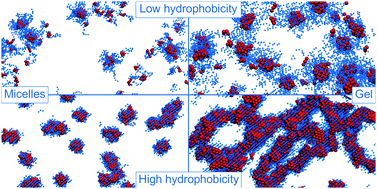Micelle formation, gelation and phase separation of amphiphilic multiblock copolymers†
Abstract
The phase behaviour of amphiphilic multiblock

* Corresponding authors
a
INRA, UMR1083 Sciences pour l'œnologie, Montpellier, France
E-mail:
Virginie.Hugouvieux@supagro.inra.fr
Fax: +33 (0)499612857
Tel: +33 (0)499612758
b INRA, UR1268 Biopolymères Interactions Assemblages, Nantes, France
c Laboratoire de Chimie, Ecole Normale Supérieure de Lyon, 46 allée d'Italie, Lyon Cedex 07, France
d Montpellier SupAgro, UMR1083 Sciences pour l'œnologie, Montpellier, France
e Université Montpellier 1, UMR1083 Sciences pour l'œnologie, Montpellier, France
The phase behaviour of amphiphilic multiblock

 Please wait while we load your content...
Something went wrong. Try again?
Please wait while we load your content...
Something went wrong. Try again?
V. Hugouvieux, M. A. V. Axelos and M. Kolb, Soft Matter, 2011, 7, 2580 DOI: 10.1039/C0SM01018A
To request permission to reproduce material from this article, please go to the Copyright Clearance Center request page.
If you are an author contributing to an RSC publication, you do not need to request permission provided correct acknowledgement is given.
If you are the author of this article, you do not need to request permission to reproduce figures and diagrams provided correct acknowledgement is given. If you want to reproduce the whole article in a third-party publication (excluding your thesis/dissertation for which permission is not required) please go to the Copyright Clearance Center request page.
Read more about how to correctly acknowledge RSC content.
 Fetching data from CrossRef.
Fetching data from CrossRef.
This may take some time to load.
Loading related content
